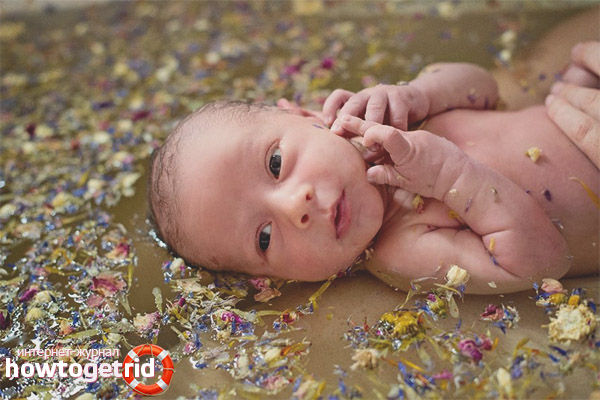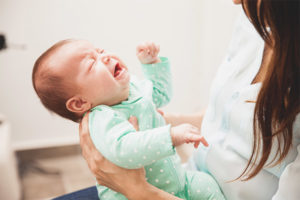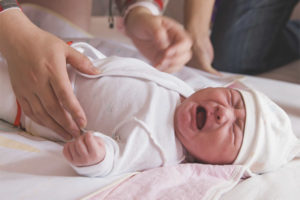The content of the article
The stork, who had flown in through the window of a young family, together with a screaming bundle, left a mass of, at first glance, insoluble questions. So, 9 months of waiting were left behind, a test called childbirth, a lush discharge from the maternity hospital, and now, the newborn baby is solemnly brought into the apartment. From this moment begins the most crucial period in the life of each person - his first year of life, every day of which, one way or another, will remain in the memory of parents forever.
The very first test, even before the upcoming sleepless night, is the first bathing of the baby. This process is exciting and joyful in its own way, but it is impossible not to take into account certain nuances that can darken it and have a detrimental effect on the future health of the child.
What you need to prepare for bathing your baby?
First of all, even before the beginning of undressing a newborn, everything necessary should be prepared so that the baby’s immersion in water is comfortable:
A room or bathroom should be well warmed up, since this category of babies is most sensitive to temperature changes. The air temperature in this room should be above 24 ° C.
So, for the full bathing process it is necessary to prepare the following:
- The tub must be decontaminated. This can be done using simple soap, and then, thoroughly washing it, pour over the boiling water.
- If there is an insert to support the baby - it is also disinfected with the bath.
- Prepare a few small soft towels or a washcloth from the same cloth. The skin of newborns easily undergoes injury and infection - it is better not to use traditional baby washcloths.
- Baby towel for taking the baby out of the bath.
- Baby soap with a neutral pH-medium.
- Clothing set: vests - 1 piece, in cold time - 1 simple and 1 of flannel fabric.
- Clean diaper.
- Caps or caps: 1 thin and 1 dense, in the cold time you should wear 2 thin and 1 dense.
- Sliders.
- Anti-scratch hands.
- Diapers - 2 pieces: thin and dense. Even if parents are ardent opponents of swaddling, at first it is better not to leave the child to sleep in the clear - he should get used to the temperature in the room, in addition, to adapt to the movements of his own legs and arms - it is important to exercise control over these processes during the daytime. in the night the child did not wake himself.
- Blanket - if the child was born in a frosty time.
- Baby oil for body treatment after bathing.
- Powder or cream under the diaper.
- Means for treating the umbilical wound: solutions of brilliant green, hydrogen peroxide and chlorophyllipt.
What should be the water for swimming?
The water for the first swim plays perhaps the most important role. That it is the main factor in the success of the whole process. So, let us consider what the requirements for the quality of water are advanced by modern pediatrics:
- Water temperature: should not be lower than 37 ° С and higher than 37.5 ° С. For accurate measurement, the modern children's goods industry provides a wide range of water thermometers.
- Water must be pre-insisted - in order to settle all the harmful impurities, then it must be filtered and boiled. Next, it must be cooled to the desired temperature.
- For additional disinfection, a pre-prepared solution of potassium permanganate is added to the water: 400 ml of water (2 ordinary cups) are collected and the manganese powder is gradually added to the water in a light pink color. More saturated colors are already dangerous for baby’s skin.
- Often in the water are added various vegetable decoctions. However, it is not worth doing this during the first bathing, if there are no necessary recommendations from a neonatologist of a maternity hospital or personal pediatrician. It should be remembered that the further frequent use of these components, like potassium permanganate, can lead to allergic reactions and disrupt the natural balance of the baby’s skin.
What can be added to water?
From the vegetable components added to water, it is possible to apply:
- Broth turns - helps get rid of diaper rash and potnichek.
- Broth Conifer - recommended for restless children, but its use up to 1 month is possible only on prescription.
- Chamomile decoction is also an excellent sedative and, in addition, it stabilizes digestion.
- Valeriana's decoction is a sedative and painkiller, but it is worth noting that not all children tolerate it well.
- Celandine decoction - has a generating effect, tightens wounds, heals microcracks in the skin.
Solutions should not be strong brewing, otherwise there may be serious consequences on the delicate skin of the baby.
Baby bathing: tips
Ideally, both parents should bathe the newborn - one to keep him in the water, especially the head, and the second to wash the skin several times with gentle movements with a towel or a special washcloth. In the first days it is better not to use soap, the baby’s skin should fully adapt to the new conditions of life.
If a child is bathed by only one of the adults - it is important to use a special insert, which is sold together with modern baths, or to keep the child so that his head lies on the elbow’s bend.
After bathing
The umbilical wound is treated first with hydrogen peroxide, then with a solution of brilliant green (dotted about the wound) and with chlorophyllipt solution (you can slightly hurt the wound).
Next, a diaper is worn, and all the prepared clothes, after which the child gently swaddles and fits.
The bathtub is disinfected both before bathing and after it, because during the process of using in plastic it is possible to form surface cracks, in which during the drying process residual cosmetic dirt may accumulate, which later may play a bad role in the child's health.
Video: bathing a newborn in a small bath for up to 1 month












To send